New England Piccalilli Relish Canning Recipe
This post may contain affiliate links, which means that I may receive a commission if you make a purchase using these links. As an Amazon Associate I earn from qualifying purchases.
This old-fashioned green tomato piccalilli recipe is easy to follow and makes in a delicious, sweet, and savory relish. Learn how to preserve piccalilli relish with this canning recipe and tutorial.
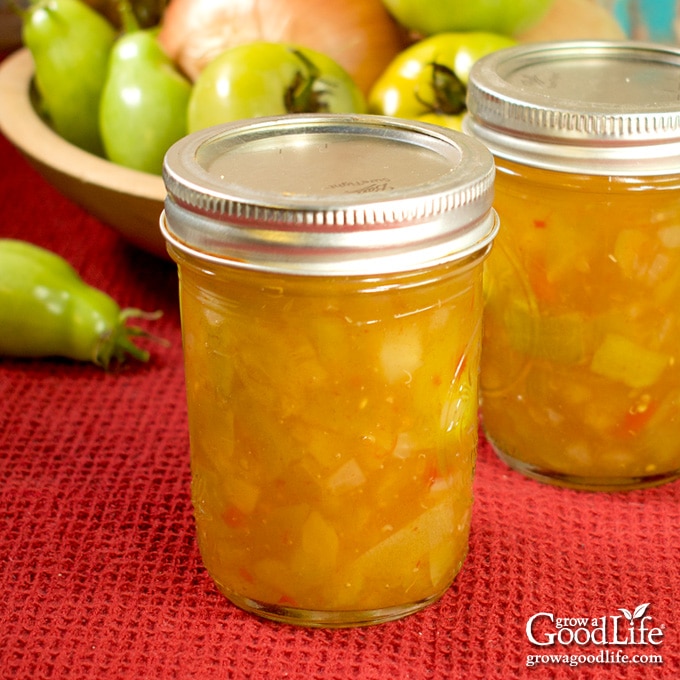
Home canned piccalilli is a great way to use up all those green tomatoes that didn’t have time to ripen before your first frost. However, this is not your British piccalilli with mixed vegetables and tangy mustard flavor.
Instead, this New England-style piccalilli is made from unripe green tomatoes, bell peppers, onions, brown sugar, apple cider vinegar, and savory spices. There is no cabbage, and it is not mustard heavy.
What is Piccalilli?
Piccalilli is a type of relish typically made with a mix of vegetables pickled in a vinegar brine solution. The result is a tasty and tangy dish that can be enjoyed as a side dish or condiment to other foods.
Piccalilli has a long history and numerous variations around the world. The recipe has been recorded in published cookbooks from as far back as the 1600s, where a version appeared in Lady Anne Blencowe’s Receipt Book as “To Pickle Lila, an Indian Pickle.” By the early 1800s, piccalilli recipes were found in numerous cookbooks in England and the United States, with ingredients ranging from vegetables to fruit and countless spice combinations.
Many old family recipes never made it to publications. Instead, the tradition of preserving pickled condiments was passed down from generation to generation, often handwritten on scraps of paper. Once tested canning recipes and processes were available in the United States and Canada, many family recipes were either lost or deemed unsafe.
What is New England Style Piccalilli?
Today you can find safe canning recipes for piccalilli relish in the Ball Blue Book Guide to Preserving, So Easy to Preserve, and the USDA Complete Guide to Home Canning books, and at the National Center for Home Food Preservation website.
While many of these are delicious, none taste like the piccalilli I grew up eating. So I began digging into vintage New England recipes, including recipes published in old newspapers, church cookbooks, and community websites.
Like my grandmother’s version, most recipes for Northern New England style piccalilli do not include cabbage, horseradish, or a lot of powdered or prepared mustard.
It also has a different spice combination that includes cloves. Many old-fashioned New England and Eastern Canada versions include cinnamon, cloves, nutmeg, allspice, and ground ginger spices that were readily available from the Caribbean region from the 17th through 19th century.
Luckily, you can safely adjust the dried spices, type of vinegar, and sugar in tested canning recipes as long as the proportion of vegetables and vinegar remains the same.
I started with a Ball green tomato relish. Then, after several years of testing, I developed a recipe close to the piccalilli I remember eating at family dinners, church suppers, potluck meals, and picnics while growing up in Northern New England.
Ways to Enjoy Piccalilli
Piccalilli is a delicious condiment that you can enjoy all year round. The sweet and savory pickled relish enhances the flavor of food by cutting through the richness of and cleansing the pallet. Here are some ways to use green tomato piccalilli:
- Sandwich Topping: Piccalilli is a delicious condiment to add flavor to sandwiches, burgers, wraps, and hot dogs. Slather a spoonful on top to add a nice sweet and savory crunch.
- Salads: Whether topping off a fresh green salad or mixing it into potato salad or macaroni salad, piccalilli relish adds a punch of tangy flavor. Try a spoonful mixed into tuna and chicken salad sandwiches too.
- Side Dish: The sweet green tomato relish can be used as a side to grilled or roasted meats, poultry, or fish. Try it with Thanksgiving turkey, pot roast, and French-Canadian tourtiere meat pie.
Tips for Making Green Tomato Piccalilli
Green tomato piccalilli is easy to make using homegrown ingredients from your garden, and you can tailor the flavor to your liking by adjusting the spices. Here are a few tips to make this canning project easier:
About the Ingredients
This sweet and savory relish is made from unripe green tomatoes, peppers, and onions. As with any canning recipe, use good quality ingredients for the best-tasting relish:
- Green tomatoes are the star of this recipe. The tart flavor of unripe tomatoes pairs well with the sweet vinegar brine. Luckily, you don’t need to peel the tomatoes for this recipe, but be sure to use unripe green tomatoes. You can include a few that have just begun to blush, but the majority should be green. Use good quality, firm green tomatoes with no signs of pest damage, disease, or cracking. Don’t use tomatoes from diseased or frost-killed vines. Tomatoes that have been affected by frost or disease might have a higher pH, making them unsafe for canning.
- Onions: You can use any bulb onion, including yellow, white, or red. Two large or three medium onions weigh about 1 pound and yield roughly 2 cups chopped. Choose onions that are firm with smooth outer skins. Avoid using bulbs with bruises, mold, or soft spots.
- Peppers: This recipe calls for red and green sweet bell peppers, but you can use any variety of pepper in this recipe as long as the total amount stays the same. Three large or five medium-sized bell peppers weigh about 1 pound and yields around 3 cups chopped. You can mix orange, red, yellow, and green sweet peppers to add lots of colors or include some hot peppers for a spicy twist.
- Vinegar: While this recipe uses apple cider vinegar, you can swap the type of vinegar used to change the flavor. Do not reduce the amount of vinegar in this recipe, but feel free to substitute it with another kind of vinegar with at least 5% acidity, including white vinegar, red wine vinegar, white wine vinegar, or a combination.
- Brown Sugar: The richness of brown sugar helps balance the tartness of the green tomatoes and vinegar. You can also use regular white sugar with excellent results. Feel free to reduce the sugar for a less sweet relish.
- Pickling Spices: This recipe uses a simple spice mix that includes a cinnamon stick, mustard seeds, and cloves, but you can use whatever pickling mix or dried spices you prefer. Check out this recipe for homemade pickling spice for more ideas.
Tools to Help with Chopping
Chopping vegetables is the most labor-consuming part of preparing this recipe. Of course, you could use a knife and cutting board to chop the tomatoes, peppers, and onion, but here are a few shortcuts that will make chopping easier:
- Use a Food Processor: A food processor chops vegetables quickly. Prepare the vegetables, cut them into chunks, add them to the food processor bowl, and then pulse to break them down into smaller, 1/4-sized pieces. Use a measuring cup to measure each ingredient, and chop more as needed to equal the amount required for the recipe.
- Try a Vegetable Chopper: My favorite kitchen tool for making relish is a vegetable chopper. It takes up very little storage space and comes in handy for making fresh salsa, dicing onions and peppers for the freezer, and evenly chopping vegetables to make this piccalilli recipe. Simply cut the vegetables to fit, apply pressure, and the tool pushes the pieces through a mesh screen into 1/4-inch pieces quickly.
Allow Plenty of Time for this Recipe
Plan on a two-day process to make this green tomato piccalilli relish. On the first day, the vegetables are prepared, sprinkled with salt, and then sit overnight. The salt helps draw out moisture to improve the texture and develop flavor.
The following day, the vegetables are rinsed and drained well before cooking in the brine to infuse flavor. Then the piccalilli is hot packed and processed in a water bath canner for shelf-stable jars.
Steps for Making Sweet Green Tomato Piccalilli
This recipe is from the Ball Complete Book of Home Preserving for “Green Tomato Hot Dog Relish.” Changes include:
- Using apple cider vinegar instead of white vinegar.
- Increasing the amount of sugar.
- Adjusting the spices for a more New England flavor.
Before you begin, reviewing this article on water bath canning at the National Center for Home Food Preservation website may be helpful: Using Water Bath Canners.
You can find a more detailed and printable recipe at the bottom of this article. Here are the illustrated steps to making New England-style piccalilli relish and how to preserve it using a water bath canner for shelf-stable jars.
Step 1: Gather your Kitchen and Canning Equipment
You will need:
- Water bath canner and canning rack
- 6 half-pint canning jars
- Canning lids and bands (new lids for each jar, bands can be reused)
- Canning tools: jar lifter, canning ladle, funnel, and bubble popper
- Kitchen scale
- Spice bag (or coffee filter and kitchen string)
- Basic kitchen supplies include a 6-quart or larger stainless steel stockpot, measuring cup, colander, kitchen towels, slotted spoon, knife, and a cutting board.
Step 2: Prepare the Vegetables (Day 1)
Prepare your vegetables the day before by washing, cutting, tossing them with salt, and letting them stand overnight.
Green Tomatoes: This recipe will need about 4 pounds of green tomatoes. Weigh the tomatoes with a kitchen scale, then rinse them well under running water. Remove the cores and finely chop them into even-sized 1/4-inch pieces using a food processor, food chopper, knife, and cutting board. Measure 6 cups of finely chopped green tomatoes and add to a large stainless steel pot.
Onions: Peel the onions and chop roughly into 1/4-inch-sized chunks. Measure 2 cups of chopped onions and add to the pot.
Peppers: Rinse the peppers well under running water, remove the stems and seeds, and chop. Measure 3 cups of chopped peppers and add to the large pot.
Salt the Vegetables: Sprinkle 1/4 cup of pickling salt over the vegetables, and stir until well combined. Cover the pot and let the vegetable stand at room temperature for 12 hours or overnight. Place the pot in the refrigerator if the weather is warmer than 75˚F.
Step 3: Make the Piccalilli (Day 2)
Drain the vegetables into a colander, rinse well with clean water to remove the excess salt, and drain thoroughly. Use your hands to press the mixture to squeeze out as much moisture as possible. Set the vegetables aside, rinse the pot, and place it on the stove.
Bundle the cinnamon, mustard seeds, cloves, and allspice in a spice bag or coffee filter tied with kitchen string.
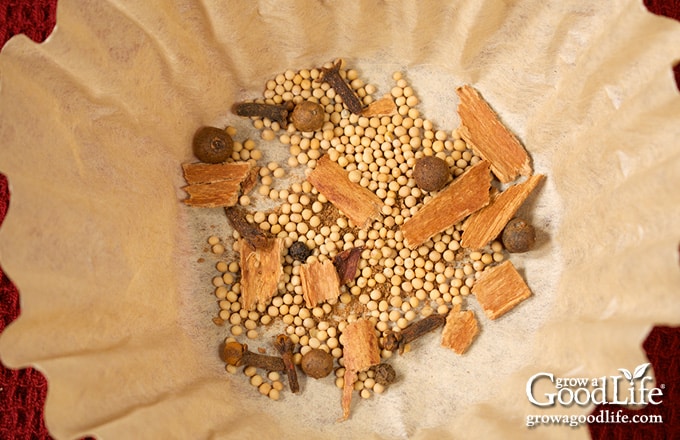
Add the vinegar, brown sugar, and pickling spice bag to the saucepan. Bring the pot to a boil over medium-high heat while stirring to dissolve sugar.
Add the drained vegetables to the pot, and stir well to combine. Let the vegetables come to a boil, and then reduce the heat and simmer uncovered until the tomatoes are transparent, about 1 hour. Stir occasionally to prevent sticking.
Get the canning equipment ready while the vegetables are simmering.
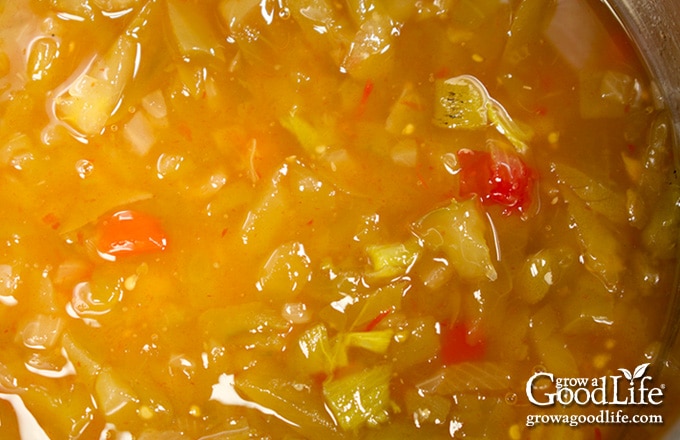
Step 4: Prepare the Canning Equipment
Wash the jars, lids, bands, and canning tools in warm, soapy water. Rinse well, and set the lids, bands, and tools aside to air dry until you are ready to use them.
Set up your water bath canner with the canning rack on a large burner of your stove. Place the jars upright in the canner, and add water to cover them. Bring the canner to a simmer (180˚F) for 10 minutes, and keep the jars hot until you are ready to fill them.
Step 5: Can the Piccalilli
Lay a towel on the counter. Remove the spice bag from the vegetable mixture and discard.
Remove a hot jar from the canner with the jar lifter, drain the water, and place it on the towel. Keep the remaining jars in the canner so they stay warm.
Place the canning funnel on the jar, and use the ladle to fill the jar with hot piccalilli leaving 1/2-inch headspace. Run the bubble popper through to release any trapped air bubbles.
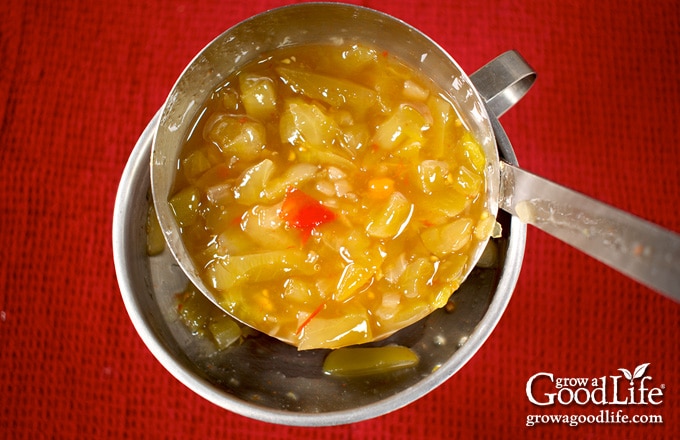
Wipe the rim with a damp towel to remove residue. Center a lid on the jar, place the band over the lid, and screw it on until fingertip tight. Place the jar back into the canner, and repeat with the rest of the jars.
Adjust the water level to cover the jars by two inches, bring the canner to a boil, start a timer, and process for the time indicated in the recipe below.
Let the jars cool, test the seals, label them, and store them in a cool, dark location. Allow at least four weeks for the green tomato piccalilli to develop flavor before opening a jar.
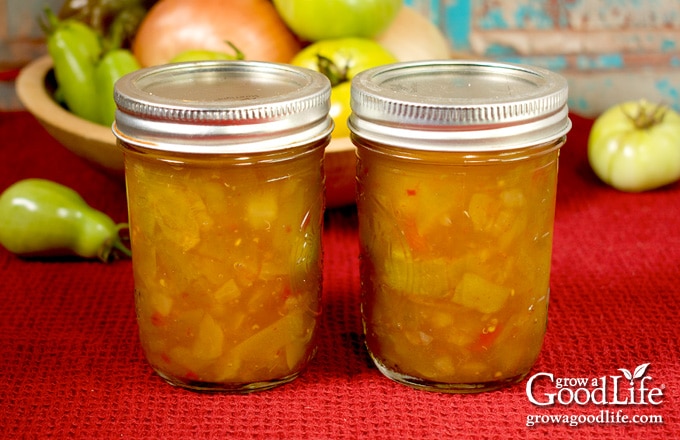
New England Piccalilli Relish Canning Recipe
Ingredients
- 6 cups finely chopped cored green tomatoes about 4 pounds before prep
- 2 large yellow onions finely chopped (about 2 cups chopped)
- 2 large green peppers seeded and chopped (about 2 cups chopped)
- 1 large red pepper seeded and chopped (about 1 cup chopped)
- 1/4 cup pickling salt also called canning salt
Pickling Brine:
- 1 cinnamon stick broken into pieces (or 1/2 teaspoon ground cinnamon)
- 4 whole allspice berries
- 1 teaspoon mustard seeds or 1 teaspoon dried mustard
- 1/4 teaspoon whole cloves
- 2 cups lightly packed brown sugar
- 2 cups apple cider vinegar
Instructions
Day 1: Prepare the Vegetables
- Wash the tomatoes well under clean running water. Remove the cores, and finely chop them into 1/4-inch pieces using a food processor, food chopper, or knife and cutting board. Measure 6 cups of finely chopped green tomatoes and add to a large stainless steel pot.
- Peel the onions, remove the ends, and chop them into 1/4-inch chunks. Measure 2 cups of finely chopped onions and add to the pot.
- Rinse the peppers well under running water, remove the stems and seeds, and chop. Measure 3 cups of finely chopped peppers and add to the large pot.
- Scatter 1/4 cup of pickling salt over the prepared vegetables, and stir until well combined.
- Cover the pot and let the vegetable stand at room temperature for 12 hours or overnight. Place the pot in the refrigerator if the weather is warmer than 75˚F.
Day 2: Make the Piccalilli
- Drain the vegetables into a colander, rinse well with clean water to remove the excess salt, and drain thoroughly.
- Use your hands to press the mixture and squeeze out as much moisture as possible. Set the vegetables aside, rinse the pot, and place it on the stove.
- Bundle the cinnamon, allspice, mustard seeds, and cloves in a spice bag or coffee filter tied with kitchen string.
- Add the vinegar, brown sugar, and pickling spice bag to the saucepan. Bring the pot to a boil over medium-high heat while stirring to dissolve sugar.
- Add the drained vegetables to the pot, and stir well to combine. Let the vegetables come to a boil, and then reduce the heat and simmer uncovered until the tomatoes are transparent, about 1 hour. Stir occasionally to prevent sticking.
Prepare the Canning Equipment:
- Wash the canning jars, lids, screw bands, and tools in hot soapy water. Rinse thoroughly to remove all suds. Set aside to air dry on a clean kitchen towel.
- Place the jar rack into the water bath canner, place jars in the canner, and add water to cover. Bring the canner to a simmer (180˚F) for 10 minutes, and keep the jars hot.
Can the Relish:
- Spread a kitchen towel on the counter. Use your jar lifter to remove a warm jar from the canner, drain it, and place it on the towel. Keep the remaining jars in the canner so they stay warm.
- Use your canning funnel and ladle to fill the jar with the relish leaving 1/2-inch headspace.
- Run the bubble popper through the jars to release air bubbles and wipe the rims. Adjust the headspace again if needed.
- Center a lid on the jar, and screw on the band until it is fingertip tight. Use the jar lifter to place the jar back into the canner, and repeat with the remaining jars.
- Once all the jars are in the canner, adjust the water level so it is 2 inches above the jar tops.
- Cover the canner and bring it to boil over high heat. Once the water boils vigorously, continue boiling and process the relish for 10 minutes at altitudes of less than 1,000 feet. Adjust processing time for your altitude if necessary (See Notes).
- When the processing time is complete, turn off the heat, remove the cover, and allow the canner to cool down and settle for about 5 minutes.
- Spread a dry kitchen towel on the counter. Remove the cover by tilting the lid away from you so that steam does not burn your face.
- Use the jar lifter to remove the jars from the canner and place them on the towel. Keep the jars upright, and don’t tighten bands or check the seals yet. Let the jars sit undisturbed for 12 to 24 hours to cool.
- After 12 to 24 hours, check to be sure jar lids have sealed by pushing on the center button on the cover. The lid should not pop up. If the lid flexes up and down, it did not seal. Refrigerate the jar and use up within a week.
- Remove the screw-on bands and wash the jars to remove any residue. Then label, date, and store them in a cool, dark location. Allow 4 weeks for the piccalilli relish to develop flavor. Use home canned jars within 12 to 18 months for the best quality. Makes about 6 half-pint jars of piccalilli.
Notes
Nutrition
Canning piccalilli is a great way to use up unripe green tomatoes. Not only is it a delicious condiment, but it also lasts for a long time. So if you have some unripe green tomatoes, don’t let them go to waste – make some piccalilli!
You May Also Like:
- Sweet Cucumber Relish Canning Recipe
- Jalapeno Salsa Canning Recipe
- Bread and Butter Pickles Canning Recipe
40+ Meals in a Jar Pressure Canning Recipes
In this eBook, you will find 50 pressure canning recipes, including 44 meals, along with homemade stocks and bone broths. Recipes include soups, stews, chilis, beans, beef, pork, and poultry. Explore the world of preserving delicious home-cooked meals for all seasons.

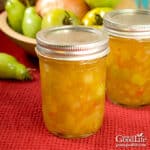

Yours is such a beautiful color and mine is kinda ugly brown. Why would there be a huge difference in color?
Carlene, It may be the type of sugar you used. If you used a dark brown sugar, it will result in a darker color. To achieve a brighter color, you might want to try using light brown sugar or regular sugar in your recipe. It could make a difference in the final appearance. Remember, though, that the taste is what truly matters, and I’m sure it’s delicious regardless of the color!
I have made for years my husband’s family piccalilli recipe that his great Grandmother brought West on a covered wagon. It’s pretty close but includes ginger and an optional addition of cayenne with the spices you use.